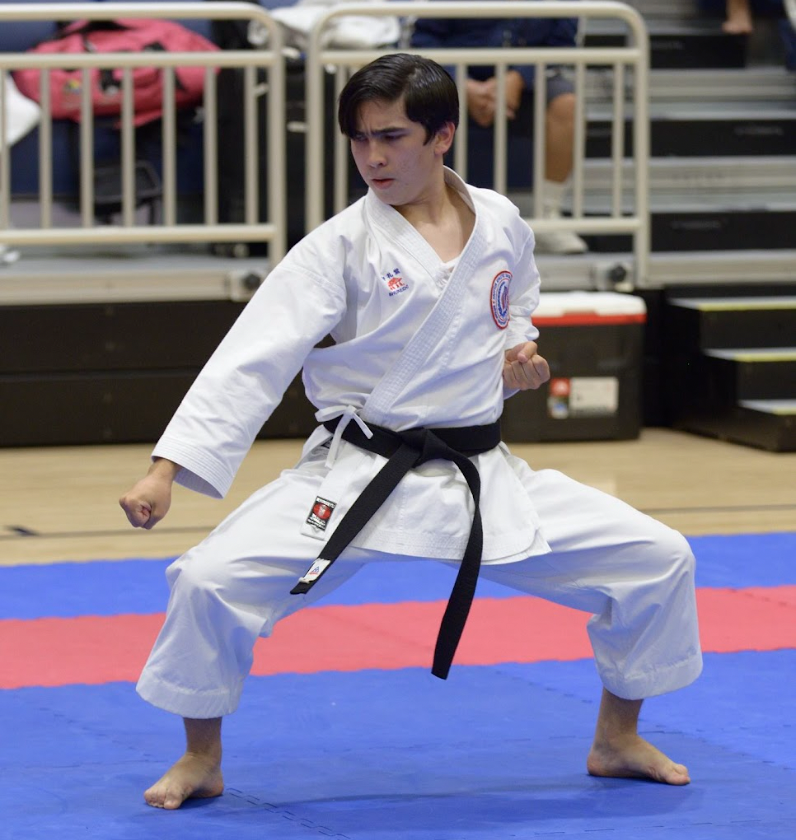Solomon competes in karate nationally
May 5, 2023

Lucas Solomon (12) was in complete control of himself. He stepped onto the red and blue foam karate mat with conviction, his every stride precise. Judges, seated at each corner of the rectangular ring, fixated their gazes. Solomon bowed.
Although he had practiced his kata, or a solo routine with detailed movements, tens of hundreds of times before, this time was different. Solomon had competed in nationals for karate three times, but in July 2022, he was at the WUKF’s World Karate Championships held at Fort Lauderdale, Florida. Consisting of 45 participating countries, WUKF (World Union of Karate Do Federations) is the international governing body of karate.
Solomon exuded confidence, focus, poise. As he went through his two-minute kata routine, Solomon’s every step, punch, kick, strike, and block was crisp. He sped up, feet moving so quickly that a single blink would change his position entirely. At other times, just as suddenly, he slowed down, steadily lowering his arms.
From his turns to his kiai (spirited yells), each of Solomon’s movements were intentional, a visual representation of techniques he hadn’t just honed, but perfected.
Hours later, the United States flag draped around his shoulders on the podium was proof: in his category, kata for 16-17-year-old males, Solomon had placed first.
His success was the culmination of a decade of practice. He had begun his karate training at UCSD 11 years ago, as a 7-year-old boy inspired by cartoons and Kung Fu Panda.
Solomon climbed the ranks for the next five years, eventually earning the green belt.
“The green belt is considered more of a novice level, so you have enough knowledge to start learning more advanced things like weapons,” Solomon said. “I had initially gone into [karate] for fun, but when I hit the green belt, I went through my first change in viewpoint. At that point, I realized I wasn’t getting much better, and I could see that the next ranks of belts are significantly more polished and more precise in their moments.”
It became all or nothing for Solomon.
“I realized I needed to do something to get to that [higher] level,” Solomon said. “So I had to consider: Do I want to keep doing this? Because if I’m going to keep doing this, I want to be like them and I want to be at that level.”
Ultimately, the decision was suppressed by a simple realization: Solomon enjoyed and loved karate. He was ready to dedicate himself to the martial art.
“I made the mental decision that I wasn’t going to go to karate just to go, but to make sure I get 100% out of my learning experience,” Solomon said. “I’m going to put in all my effort when I’m there. I want to do [karate] seriously.”
Once he reached the next belt, brown, Solomon began competing at a national level.
In order to qualify for nationals, competitors must have earned a medal at a regional tournament, which Solomon had been competing in since he had a green belt. Solomon went on to compete in nationals for three years, during which he earned two golds and one bronze in weapons.
However, earning a spot on the US national karate team does not require the competitor to have a specific placement in nationals.
Instead, for worlds, one must compete in the Ozawa Cup and in team trials where national coaches select the team themselves.
Before he qualified for worlds, Solomon earned the first rank of the black belt in karate. The specific style he learned is called Ryuei-ryu, one that originated in Okinawa, Japan.
“What’s unique about [Ryuei-ryu] is that [while sparring] we do a lot of attacks and blocking at the same time,” Solomon said. “There’s a lot of blocking and punching with the same move. A lot of our movements, like a double step and double punches, are more flowy and versatile as opposed to some styles which are more rigid and stable.”
Solomon frequently utilizes this fluid technique in kumite, or sparring. Kumite is one of the three aspects of a karate competition alongside kata and kobudo, or weapons. Unlike kata and kobudo, in kumite, the competitor engages in combative fighting with their opponent.
“I’m always shorter than most competitors [in kumite], so I don’t have as much reach,” Solomon said. “What I usually do if they come in is block and hit at the same time, because I can deflect with one hand and hit with the other. It’s also good to stay versatile though, so sometimes it’s good to go really aggressive and go fast with multiple punches, but sometimes it’s better to bait them into an attack and use their momentum on them.”
Outside the ring, when he isn’t fighting, Solomon watches his opponents in their other rounds, mentally noting what moves they often utilize and how he could counter them.
But once he steps inside the ring, Solomon said, he’s in complete focus.
“You’re in the zone,” Solomon said. “You’re not even thinking about what you’re really doing, because you’re fighting. You just go there and do your best. You can’t consider what mistakes you made. You just have to keep going through it and completely dial in.”
The goal of kumite is not to knock your opponent down, but rather score higher. Thus, points are awarded to a competitor for executing punches or kicks with the proper form.
Excessive contact, for one, is prohibited.
“None of [kumite] is done maliciously,” Solomon said. “One of my favorite parts is being able to make friends with the people you compete against. Although everyone’s competitive, you actually get to know the people you’re competing against. There are some people that I always end up competing against because they’re in Southern California, so we’re just trading off who gets which medal each year. It’s always fun to see them.”
Whether it be his Romanian opponents that he befriended, the kata seminar he taught at worlds, or the teammates he practices with and fondly refers to as ‘family,’ Solomon has found a community through the sport. Through these relationships, Solomon gained exposure to various karate styles.
“It’s cool to see different styles [of karate],” Solomon said. “At worlds, there were seminars for teaching different styles, and you could learn from different people from around the world. I was also able to help out because the [ryuei-ryu style and competitors] decided to do a kata seminar, so I was able to help teach other people kata.”
Solomon has also taken up teaching younger students since he earned his black belt.
“I help teach [the younger students] the movements, but depending on the age, some of it is more behavioral [such as listening to elders] because they’re kids,” Solomon said. “I also help teach them kata, but I don’t teach super high content, even as a black belt, because I’m still working on them myself.”
Solomon imparts discipline and respect in his lessons, skills crucial to the martial art.
But what he learns in karate extends far beyond the competition itself.
“Karate trains your mental state,” Solomon said. “You learn a lot of discipline and perseverance. Life lessons that are still applicable from karate today will be applicable for the rest of my life. I also enjoy learning about the traditions in karate, because there’s such a rich history. There’s a lot I love about karate.”
Solomon hopes to continue his love for karate in college, potentially even competing at the collegiate level.
“Most colleges have a karate club, though, but it won’t be the same style as my current style Ryuei-ryu,” Solomon said. “I’m very open to learning a different style because I think I need to expand what I know. I probably won’t be at the same competitive level since I’ll be competing in that different style, but I want to continue karate in college and maybe even for the rest of my life.”


